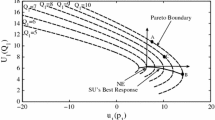Abstract
Scarcity problem of radio spectrum resource stimulates the research on cognitive radio technology, in which dynamic spectrum allocation attracts lots of attention. For higher access efficiency in cognitive radio context, we suggest a fully dynamic access scheme for primary and secondary users, which is modeled by a master-slave stochastic knapsack process. Equilibrium behavior of this knapsack model is analyzed: expressions of blocking probability of both master and slave classes are derived as performance criterion, as well as forced termination probability for the slave class. All the theoretic results are verified by numeric simulations. Compared to traditional opportunistic spectrum access (OSA), which can be regarded as half dynamic due to primary users’ rough preemption, our scheme leads to less termination events for the secondary users while keeping the same performance for the primary class, thus promotes the system access performance. Nonideal spectrum sensing algorithm with detection error is also taken into consideration to evaluate its impact on system access performance, which is a practical issue for implementation.









Similar content being viewed by others
References
Mitola J (2000) Cognitive radio: an integrated agent atchitecture for software defined radio. Ph.D. dissertation, KTH, Stockholm, Sweden
Webb W (2007) Wireless communications: the future. Wiley, New York
Federal Communications Commission (2005) Notice of proposed rule making and order: facilitating opportunities for flexible, efficient, and reliable spectrum use employing cognitive radio technologies. ET Docket No. 03-108
Haykin S (2005) Cognitive radio: brain-empowered wireless communications. IEEE J Sel Areas Commun 23(2):201–220
Akyildiz IF, Lee W-Y et al (2006) Next generation dynamic spectrum access cognitive radio wireless networks: a survey. Comput Netw 50:2127–2159
Zhu X, Shen L, Yum T-SP (2007) Analysis of cognitive radio spectrum access with optimal channel reservation. IEEE Commun Lett 11(4):304–306
Diego Pacheco-Paramo VP, Martinez-Bauset J (2009) Optimal admission control in cognitive radio networks. In: Proc. 4th int. conf. on cognitive radio oriented wireless networks and commun.
Kalil MA, Al-Mahdi H, Mitschele-Thiel A (2009) Analysis of opportunistic spectrum access in cognitive ad hoc networks. In: ASMTA 2009, pp 16–28
Stevenson C, Chouinard G, Lei Z, Hu W, Shellhammer S, Caldwell W (2009) IEEE 802.22: the first cognitive radio wireless regional area network standard. IEEE Commun Mag 47:130–138
Cabric D, Mishra SM, Brodersen RW (2004) Implementation issues in spectrum sensing for cognitive radios. In: 38th Asilomar conference on signals, systems and computers, IEEE, vol 1, pp 772–776
Zeng Y, Liang Y-C, Hoang AT, Zhang R (2010) A review on spectrum sensing for cognitive radio—challenges and solutions. EURASIP J Adv Signal Process 2010:1–15
Hong X, Wang C, Chen H, Zhang Y (2009) Secondary spectrum access networks. IEEE Veh Technol Mag 4:36–43
Capar E, Martoyo I, Weiss T, Jondral E (2002) Comparison of bandwidth utilization for controlled and uncontrolled channel assignment in a spectrum pooling system. In: 55th conference on vehicular techniques, IEEE, vol 3, pp 1069–1073
Martinez-Bauset J, Pla V, Pacheco-Paramo D (2009) Comments on ‘Analysis of cognitive radio spectrum access with optimal channel reservation’. IEEE Commun Lett 13:739
Wang Y, Ren P, Su Z (2011) A POMDP based distributed adaptive opportunistic spectrum access strategy for cognitive ad hoc networks. IEICE Trans Commun E94-B(06):1621–1624
Yucek T, Arslan H (2009) A survey of spectrum sensing algorithms for cognitive radio applications. IEEE Commun Surv Tutor 11(1):116–130
Ghasemi A, Sousa ES (2007) Optimization of spectrum sensing for opportunistic spectrum access in cognitive radio networks. In: 4th conference on consumer communications and networking, IEEE, pp 1022–1026
Geirhofer S, Tong L, Sadler BM (2006) A measurement-based model for dynamic spectrum access in WLAN channels. In: IEEE military communications conference, pp 1–7
Yin W, Ren P, Cai J, Su Z (2011) A pilot-aided detector for spectrum sensing of DVB-T signals in cognitive radio networks. Wirel Commun Mob Comput. doi:10.1002/wcm.1170
Yin W, Ren P, Su Z, Ma R (2011) A multiple antenna spectrum sensing scheme based on space and time diversity in cognitive radios. IEICE Trans Commun E94-B(05):1254–1264
Zeng Y, Liang Y (2009) Eigenvalue-based spectrum sensing algorithms for cognitive radio. IEEE Trans Commun 57:1784–1793
Liang Y-C, Zeng Y, Peh ECY, Hoang AT (2008) Sensing-throughput tradeoff for cognitive radio networks. IEEE Trans Wirel Commun 7:1326–1337
Peh E, Liang Y-C (2007) Optimization for cooperative sensing in cognitive radio networks. In: Proceedings of the IEEE wireless communications and networking conference (WCNC’07), pp 27–32, Hong Kong
Ghasemi A, Sousa E (2005) Collaborative spectrum sensing for opportunistic access in fading environments. In: Proc. IEEE int. symposium on new frontiers in dynamic spectrum access networks, pp 131–136, Baltimore, Maryland, USA
Gandetto M, Regazzoni C (2007) Spectrum sensing: a distributed approach for cognitive terminals. IEEE J Sel Areas Commun 25:546–557
Ross KW, Hancock PJ (1995) Multiservice loss models for broadband telecommunication networks. Springer, New York
Acknowledgements
This work was supported by the National Major Special Projects in Science and Technology of China under Grant 2010ZX03003-001, 2010ZX03005-003, and 2011ZX03003-003-04, National Key Technology R&D Program under Grant 2008BAH30B12.
Author information
Authors and Affiliations
Corresponding author
Rights and permissions
About this article
Cite this article
Zhang, S., Yang, F., Zhao, M. et al. The Master-Slave Stochastic Knapsack Modeling for Fully Dynamic Spectrum Allocation. Mobile Netw Appl 17, 721–729 (2012). https://doi.org/10.1007/s11036-012-0385-z
Published:
Issue Date:
DOI: https://doi.org/10.1007/s11036-012-0385-z




